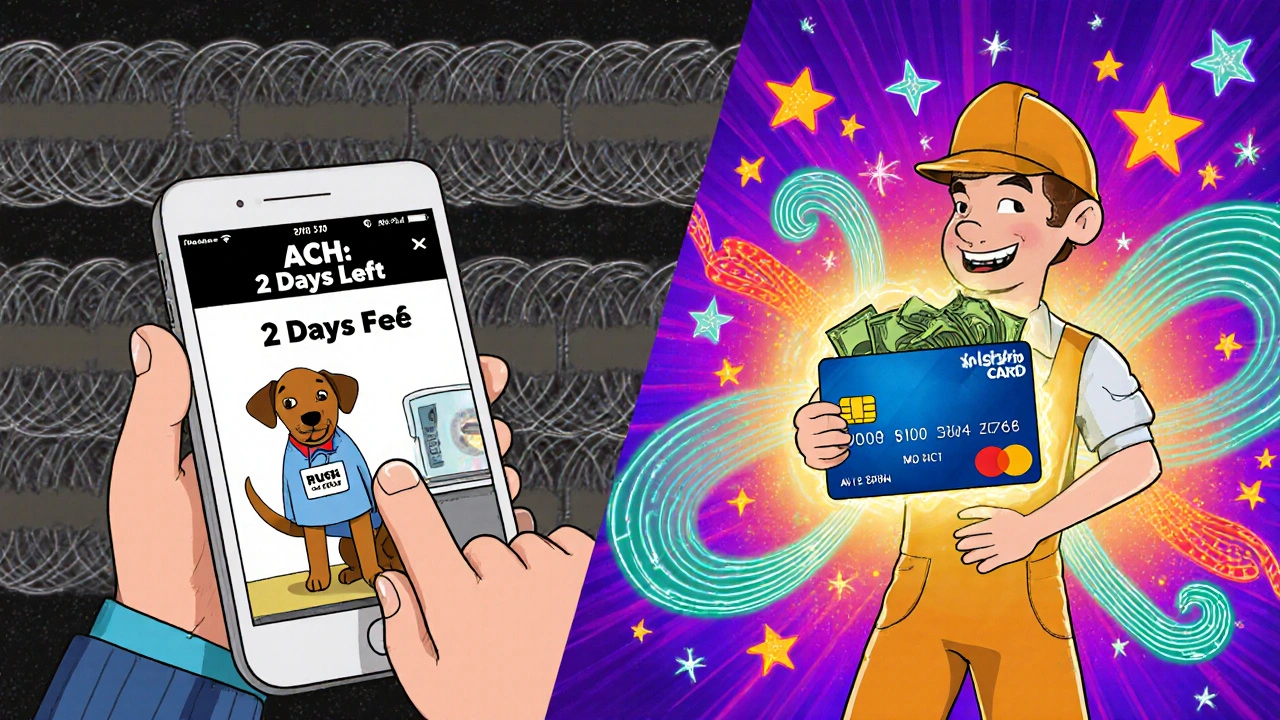EWA Settlement Time Calculator
When will you get paid?
Select your payment method and time of request to see when your EWA funds will arrive.
Estimated Arrival Time
Fee Information:
ACH: $0.20 per transaction
RTP: $0.40-$1.50 per transaction
Push-to-Card: 0.5%-1.5% of transfer amount + $0.10-$0.30
Note: ACH settlement time depends on whether Same-Day ACH is selected and if request is made before 4:45 PM ET on business days. RTP and Push-to-Card work 24/7 with some limitations.
Imagine you wake up to a flat tire, a broken appliance, or an unexpected medical bill - and your next paycheck is still three days away. If you’re using earned wage access (EWA), how quickly you get your money can mean the difference between fixing the problem and falling behind. The truth? Not all EWA services are created equal. The speed at which your earned wages hit your account depends entirely on which payment rail your employer’s provider uses: ACH, RTP, or Push-to-Card.
ACH: The Slow but Sure Backbone of EWA
Most EWA providers still rely on ACH - the same system that handles direct deposits and bill payments. It’s reliable, cheap, and works with every bank account in the U.S. But it’s not fast. Standard ACH transfers take 1 to 3 business days. Even Same-Day ACH, which became more common after 2021, only works if you request the transfer before 4:45 p.m. ET on a weekday. No weekends. No holidays. No exceptions.For employers and providers, ACH is the default because it costs as little as $0.20 per transaction. That’s why 78% of EWA services still use it as their main option. But for employees? Waiting 48 hours for $100 you already earned feels like a punch in the gut. Reddit users call it "the worst part of EWA." One person wrote: "I used my company’s EWA app to cover my dog’s emergency vet bill. Got approved in 2 minutes. Then waited 2 days for the money. By then, the vet had already charged me late fees."
ACH also requires full bank account and routing numbers. That means more data exposure. If a provider gets hacked, your banking details are at risk. Citizens Bank’s 2023 security report flagged this as a top vulnerability in EWA systems.
RTP: Instant, But Not Everywhere
Real-Time Payments (RTP) is the closest thing to magic in the payment world. Once you request your money, it lands in your account - usually within 10 to 15 seconds. And it works 24/7, even on Christmas. No batching. No delays. No waiting for bank hours.RTP is powered by The Clearing House, a private network that only connects to about 55% of U.S. banks. That’s the catch. If your employer uses a small regional bank or a credit union, RTP might not work at all. One Reddit user, u/WageAccessor, said: "I’ve had RTP fail twice in three months because my credit union isn’t on the network. Then I’m stuck with ACH."
Providers like DailyPay and Even offer RTP as a premium upgrade - usually for $1.99 to $4.99 per instant transfer. The cost to the provider? Around $0.40 to $1.50 per transaction. That’s more than ACH, but less than Push-to-Card. Still, RTP is growing fast. In 2023, RTP usage in EWA jumped 142% year-over-year.
Another advantage? RTP transactions are final. Once sent, they can’t be reversed - unlike ACH, which allows reversals for up to 60 days under Regulation E. That’s good for providers, but it also means if you accidentally request $200 instead of $20, you’re out of luck unless you ask the provider to manually correct it.

Push-to-Card: Fastest for Most People
If you want your money now - and you don’t care about the bank account - Push-to-Card is your best bet. Instead of sending money to your checking account, it pushes funds directly to your debit or prepaid card. Think of it like reloading a gift card, but with your own earned wages.Settlement time? Usually 30 seconds to 5 minutes. That’s faster than RTP in many cases because it skips the bank entirely. You don’t need to link your bank account. No routing numbers. No ACH delays. Just your card number and a tap.
But there’s a price. Push-to-Card costs more. Fees range from 50 to 150 basis points - that’s 0.5% to 1.5% of the transfer amount - plus $0.10 to $0.30 per transaction. For a $100 withdrawal, that’s $0.50 to $1.50 in fees. Providers pass this cost to users, which is why it’s almost always a premium feature.
Still, users love it. Trustpilot reviews for EWA apps using Push-to-Card average 4.5 stars. One user wrote: "My car broke down at 2 a.m. I pulled $50 through EWA. Got it on my debit card in 3 minutes. Paid the tow truck. No stress."
It’s not perfect. Card issuers can delay access. Some prepaid cards take up to 24 hours to reflect the deposit. But overall, Push-to-Card has the broadest reach. Virtually every adult in the U.S. has a debit or prepaid card. That’s why 22% of EWA providers use it - and why user retention is 27% higher for services offering it.
Which One Should You Use?
Here’s how to pick the right settlement option:- Use ACH if you’re not in a rush and want to avoid fees. Best for regular, planned withdrawals.
- Use RTP if your bank supports it and you need instant access. Great for emergencies, but check your bank first.
- Use Push-to-Card if you need money fast, don’t want to link your bank, and don’t mind paying a small fee. Best for unpredictable emergencies.
Most EWA providers now offer a hybrid model. Standard withdrawals go through ACH. Instant access? That’s RTP or Push-to-Card - for a fee. The Federal Reserve found that 63% of EWA providers use this split approach. It’s smart. ACH keeps costs low. Instant rails keep users happy.

The Future: Hybrid Settlement Engines
The EWA market is growing fast - projected to hit $142.7 billion by 2027. And payment rails are evolving. In November 2023, The Clearing House and Nacha announced a new partnership called "RTP Express." It lets EWA providers automatically route urgent ACH requests to RTP if the recipient’s bank supports it. That means you might not even have to choose - the system picks the fastest option for you.FedNow, the Federal Reserve’s new real-time payment system, is also catching up. It launched in July 2023 with a $100,000 limit. By December 2023, that limit jumped to $500,000 - making it viable for EWA. But FedNow still only works with banks that have signed up. That’s fewer than RTP.
Meanwhile, Push-to-Card keeps winning on accessibility. Alacriti’s November 2023 analysis predicts it’ll remain the dominant instant settlement method through 2025. Why? Because you don’t need a bank account to use it. You just need a card.
The CFPB made it clear in October 2023: EWA providers must clearly disclose settlement times. No more "instant access" claims if it takes two days. Transparency is here to stay.
What This Means for You
If you’re using EWA, don’t just sign up and forget it. Check your provider’s settings. See what settlement options you have. Ask:- How long does each option take?
- Is there a fee for instant access?
- Do I need to link my bank account?
Most people don’t. They assume "instant" means "right now." But if your provider uses ACH, "instant" just means "approved instantly." The money still takes days.
Know the difference. Know your options. And if you need money fast - don’t wait for the bank. Use the card.
How long does it take to get paid with EWA using ACH?
With standard ACH, it takes 1 to 3 business days. Same-Day ACH can get your money in the same day - but only if you request it before 4:45 p.m. ET on a weekday. No weekends or holidays. ACH is slow but cheap, and it works with every U.S. bank account.
Is RTP faster than Push-to-Card for EWA?
RTP settles in 10 to 15 seconds, and Push-to-Card takes 30 seconds to 5 minutes. So technically, RTP is faster. But Push-to-Card often feels faster because it doesn’t depend on your bank’s participation. If your bank doesn’t support RTP, you’re stuck with ACH - even if you picked "instant." Push-to-Card works with any debit or prepaid card, no bank link needed.
Why do some EWA services charge extra for instant access?
Because instant payment rails cost more. ACH costs around $0.20 per transaction. RTP costs $0.40-$1.50. Push-to-Card costs 0.5%-1.5% of the transfer amount plus a flat fee. Providers use the extra charge to cover those higher costs. It’s not a profit grab - it’s a cost recovery. Most users pay the fee only when they need money urgently.
Can I get my money instantly without a bank account?
Yes - with Push-to-Card. This method sends your earned wages directly to your debit card, prepaid card, or even a mobile wallet like Cash App or Venmo (if linked). You don’t need to provide your bank routing number or account number. That’s why it’s popular with gig workers, unbanked employees, and people who prefer not to link their checking account.
What’s the most reliable EWA settlement method?
ACH is the most reliable because it works with every bank and credit union in the U.S. It’s the only option that reaches 100% of bank accounts. RTP only works with about 55% of banks, and Push-to-Card requires a card - which most people have, but not everyone. If reliability matters more than speed, ACH wins. If speed matters more, go with Push-to-Card or RTP if available.
Are there risks with using Push-to-Card for EWA?
The biggest risk is the fee - it can be 1% or more per transaction. Over time, that adds up if you use it often. Also, some card issuers delay the deposit by up to 24 hours. And if your card is lost or frozen, you can’t receive funds until you update your card details. But security-wise, it’s safer than ACH because it doesn’t expose your bank account number.
Will RTP replace ACH in EWA soon?
No - not soon. ACH will still handle at least 60% of EWA transactions through 2027, according to the Federal Reserve. RTP is growing fast, but it’s limited by bank participation. Most employers won’t switch entirely because ACH is cheaper and universal. RTP and Push-to-Card are becoming premium add-ons, not replacements.
How do I know which settlement method my EWA provider uses?
Check the app or website. Look for labels like "Standard Transfer" (usually ACH) and "Instant Access" or "Card Deposit" (RTP or Push-to-Card). The provider must legally disclose expected settlement times under CFPB rules. If it’s not clear, call customer support and ask: "How long until my money arrives for each option?"
